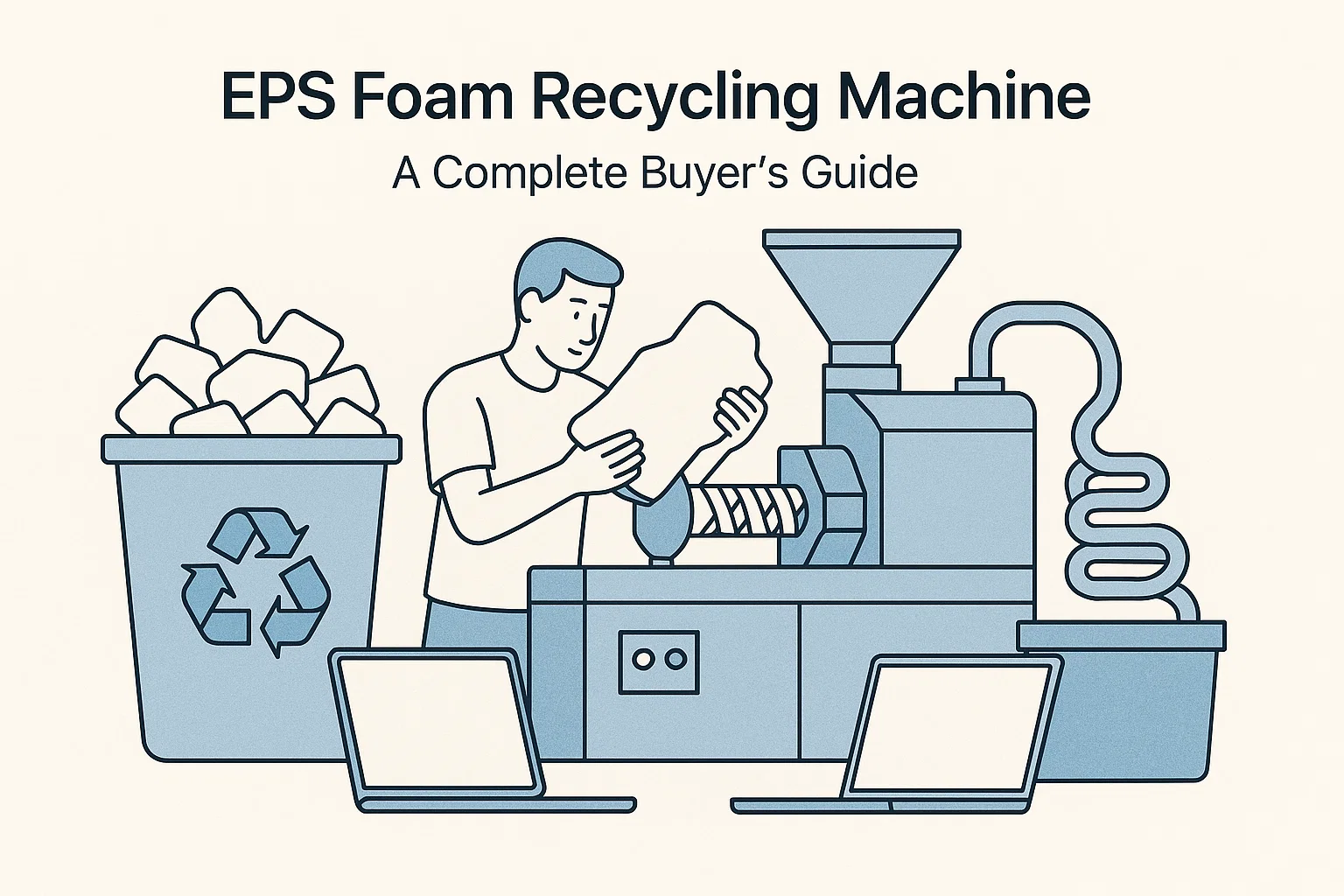Kompletní nákupní průvodce pro výběr stroje na recyklaci EPS pěny
Výběr toho správného %% S více než 15 lety zkušeností v průmyslu likvidace odpadů a recyklačních zařízení pomáhá John podnikům přeměnit náklady na likvidaci na příjmové zdroje. Jeho odbornost vedla stovky firem po celém světě k implementaci praktických a ziskových řešení pro recyklaci EPS.
%%

EPS pěnový recyklační stroj
%%
- je klíčovým podnikatelským rozhodnutím pro jakoukoli firmu, která zpracovává velké množství rozšířené polystyrenové pěny (často nazývané Styrofoam). Tento lehký, ale objemný odpad nejenže spotřebovává cenný skladovací prostor, ale také vede k vysokým nákladům na přepravu a skládkování. Správná investice do vybavení může tento finanční břemen proměnit v ziskový aktiv. %%
- Nicméně, trh je plný možností a technických specifikací, které mohou být matoucí. Tento průvodce poskytuje jasný rámec, který vám pomůže udělat informované rozhodnutí na základě specifických potřeb vaší společnosti. Vysvětlíme různé typy strojů a podrobněji rozebereme klíčové faktory, které musíte zvážit. %%
- Proč vaše podnikání potřebuje stroj na recyklaci EPS pěny %%
Než se ponoříme do technických detailů, je důležité si jasně dát do pořádku obchodní případ pro investici do stroje na recyklaci EPS pěny. To je více než ekologická iniciativa; je to moudré finanční rozhodnutí.
%%
Zřetelné snížení nákladů:
%% Až 98% objemu EPS pěny tvoří vzduch. Recyklační stroj snižuje tento objem v poměru až 50:1 nebo dokonce 90:1. To znamená prudký pokles frekvence přepravy odpadů a přepravních nákladů, spolu s úsporami na neustále rostoucích nákladech na skládkování.
- Výhody: %%
- Nevýhody: Vytvořte nové příjmy:
%%
%% Zahuštěné bloky nebo ingoty EPS jsou cennými komoditami používanými k výrobě produktů jako obrazy, architektonické profilové prvky a další plastové výrobky. Existuje stabilní poptávka po tomto materiálu, což vám umožňuje prodávat jej recyklačním firmám a získávat pravidelný příjem.
- Výhody: %%
- Nevýhody: Zlepšete firemní image a splnění předpisů:
%%
Implementace programu recyklace EPS ukazuje na váš závazek k udržitelnosti. To posílí vaši značku a pomůže vám splňovat stále přísnější ekologické předpisy.
%%Klíčové rozhodnutí: Chladicí kompresor nebo teplotní zahušťovač?
%%
To je první a nejdůležitější rozhodnutí, které učiníte. Oba stroje účinně snižují objem EPS, ale jejich principy fungování, výstup a ideální použití jsou velmi odlišné.
%%
- EPS chladicí kompresor %%
Jak to funguje:
%%
- Příklad výpočtu: Kompresor používá silnou fyzickou sílu, obvykle prostřednictvím techniky poháněné šroubem, k komprimování EPS pěny na husté, pevné bloky. Celý proces nevyžaduje teplo, což vede k nižší spotřebě energie.
%%
Nízká spotřeba energie, bezpečnější provoz (žádné páry), rychlý start/ukončení.
- %% Poměr komprese je obvykle nižší než u zahušťovače (asi 50:1), což znamená, že výsledné bloky jsou pro stejnou hmotnost trochu větší.
%%
EPS teplotní zahušťovač
- %% Zahušťovač nejprve rozdrtí EPS pěnu, poté ji pomocí tepla zpracuje do pastovitého stavu. Poté je extrudována a ochlazena do velmi hustých ingotů.
%%
Vysoký poměr komprese (až 90:1), vyrábějící velmi husté, kompaktní ingoty, které maximalizují úspory na přepravě a skladování.
- %% Vyžaduje předehřívací období, spotřebovává více energie a musí být provozován v dobře větrané oblasti k řízení párami z tavení procesu.
%%
Prozkoumejte naše EPS recyklační stroje
- %%
- Připraveni proměnit váš EPS odpad na cenný aktiv? Objevte širokou nabídku vysokorychlostních kompresorů a zahušťovačů od společnosti Energycle Machine navržených pro efektivitu a spolehlivost. %%
- Zobrazit specifikace stroje %%
- 7 klíčových faktorů, které zvážit při výběru stroje
Jakmile máte obecnou představu o typu stroje, který potřebujete, je čas podrobněji prozkoumat, zda konkrétní model vyhovuje vašim požadavkům. Pečlivě zvažte tyto sedm faktorů.
%%
- 1. Posoudit objem a typ vašeho EPS odpadu
- %%
- To je počáteční bod vašeho rozhodnutí. Potřebujete přesný obraz toho, kolik EPS odpadu vy产te denně nebo týdně. Je to čistá, suchá pěna z balení, nebo je to mokrá a kontaminovaná pěna, jako jsou rybí krabice?
- %%
- Co stojí a jak dlouho trvá dodání dílů jako nože a šrouby?
4 kroků nákupního procesu
S touto znalostí můžete nyní následovat systémový čtyřkrokový proces pro dokončení nákupu.
Krok 1: Interní audit odpadů
Přesně zjistěte množství EPS odpadů. Dokumentujte jeho zdroj, objem, hmotnost a čistotu. To jsou nejdůležitější údaje, které sdělíte dodavatelům.
Krok 2: První ověření a kontaktování
Na základě objemu odpadů a podmínek na místě rozhodněte, zda je vhodnější kompresor nebo densifikátor. Kontaktujte několik spolehlivých dodavatelů s vašimi údaji z auditu pro prvotní doporučení a nabídky.
Krok 3: Testování vzorků a due diligence
Odeslání vzorků EPS odpadů vašim vybraným dodavatelům k testování. Pokud je to možné, požádejte o záznam videa stroje v akci nebo navštivte stávajícího zákazníka. Vidět je věřit.
Krok 4: Finální rozhodnutí a smlouva
Porovnejte výkon zařízení, cenu, návratnost investic a služby po prodeji. Před konečným rozhodnutím pečlivě prozkoumejte podmínky smlouvy, zejména pokud jde o dodání, instalaci, školení a záruku.
Často kladené otázky (FAQ)
Otázka: Kolik stojí EPS recyklační stroj?
Odpověď: Cena se výrazně liší. Malý studený kompresor by mohl začínat kolem $20,000, zatímco velkokapacitní horký-melting densifikátor může přesáhnout $100,000. konečná cena závisí na typu stroje, kapacitě, značce a volitelných funkcích.
Otázka: Můžu recyklovat mokrý nebo kontaminovaný EPS pěnu?
Odpověď: Ano, ale může to vyžadovat dodatečné kroky. Například rybí krabice z rybářských trhů musí být nejprve umyté a vysušené, protože nadbytečná vlhkost a kontaminanty mohou snížit kompresní efektivitu a potenciálně poškodit stroj. Některé pokročilé modely mají lepší toleranci na nečistoty.
Otázka: Jaká je tržní hodnota recyklovaných EPS bloků/ingotů?
Odpověď: Recyklovaný EPS je cenný komodita. Cena se pohybuje s tržní nabídkou a poptávkou, ale obecně je stabilní. Můžete kontaktovat místní recyklační firmy nebo výrobců plastů pro aktuální ceny. Váš dodavatel by také měl být schopen poskytnout relevantní tržní informace. Pro více informací se můžete obrátit na autoritativní zdroje jako je EPS Industry Alliance.
Závěr
Výběr toho správného %% Je strategická investice, která může výrazně zlepšit finanční a ekologickou výkonnost vaší společnosti. Klíčem je důkladné porozumění vlastním provozním potřebám a jejich vyvážení s technickými schopnostmi dostupných strojů. Nezaměřujte se pouze na počáteční cenu a posuzujte dlouhodobou hodnotu, včetně úspor v provozu, podpory údržby a návratnosti investic.
Dodržováním kroků a posuzovacích faktorů uvedených v této příručce můžete jistě učinit moudré rozhodnutí, které bude sloužit dlouhodobým zájmům vašeho podnikání. Pokud potřebujete odbornou pomoc při analýze vaší specifické situace, tým odborníků v Energetický stroj je připraven vám pomoci. Navštivte naši domovskou stránku na Energetický stroj pro prozkoumání více řešení.



